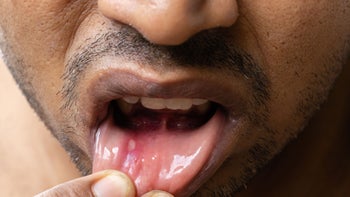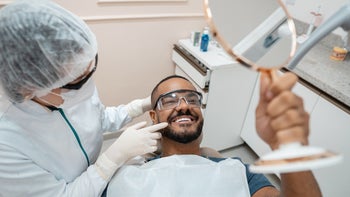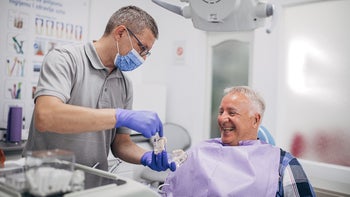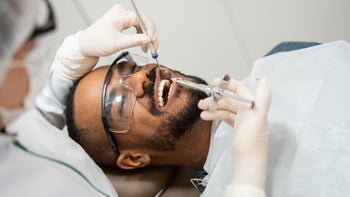
How Much Does Invisalign Cost Without Insurance?
Key takeaways:
Invisalign is a popular brand of orthodontic treatment. It uses clear plastic dental aligners instead of traditional braces to move teeth over time.
Invisalign costs can range from $1,800 to $9,500 per treatment course, depending on how complex the orthodontic problem is. The average cost for a teenager is $3,000.
You can save money on Invisalign by checking for insurance coverage, comparing prices between orthodontists, and looking into discounts or payment plans.
Table of contents

People with irregular teeth often skip braces and opt for clear plastic dental aligners instead. Invisalign is among the best-known brands of clear dental aligners. But at a cost starting at several thousand dollars, Invisalign treatment can be quite an investment.
Even with dental insurance, your out-of-pocket costs may be significant. But there are a few ways to make Invisalign more affordable.
How much does Invisalign cost without insurance for teens and adults?
Invisalign costs range from $1,800 to $9,500, depending on the complexity of the problem. The average Invisalign cost for a teenager is $3,000. However, the cost for a teenager ranges anywhere from $2,000 to $5,000.
Search and compare options
For people with minor orthodontic problems, Invisalign Express may be an option. It costs about $1,800 to $3,000, with an average cost of $2,400. Treatment with Invisalign Express is shorter — usually a few months — and uses fewer aligner trays.
The full Invisalign treatment — also known as Invisalign Comprehensive — is for complex orthodontic cases and is the most commonly used treatment course. For example, Invisalign Comprehensive can fix moderate to severe tooth misalignments using as many aligner trays as needed. A full Invisalign treatment for an adult costs about $5,700 on average. But the price can range from $3,500 to $9,500. This treatment may take 12 to 18 months on average.
How does the cost of Invisalign compare to braces?
Your Invisalign cost may be more or less than what you would pay for traditional braces, depending on your treatment plan. Here’s a table comparing the cost and other features of Invisalign and metal braces:
Feature | Invisalign | Metal braces |
Cost | $1,800-$9,500 | |
Treatment duration | 12-18 months (Invisalign Comprehensive) A few months (Invisalign Express) | |
Comfort | Aligners that can be removed when needed | Braces affixed to teeth |
Aesthetics | Clear aligners, less noticeable | Visible, with metal brackets and wires |
Office visits |
Invisalign vs. other clear aligners
Invisalign is generally more costly than other brands of clear aligners. For example, a treatment course using at-home clear aligners such as Byte costs $1,999 for daytime aligners or $2,399 for nighttime aligners.
The two biggest differences between Invisalign and other clear aligners including Byte are:
Accuracy in treatment planning
Need for face-to-face consultation
Invisalign treatment plans are customized by an orthodontist you see in the office. Users of at-home clear aligners make impressions of their teeth themselves at home. Their progress is then monitored through phone apps and online communication with remote dentists or orthodontists. Eliminating in-person dental care allows at-home clear aligner companies to charge less than the maker of Invisalign for treatment.
Invisalign vs. braces: Clear aligners like Invisalign aren’t the same as traditional braces. Learn more about the pros and cons of each, plus how much you can expect to pay.
Should you try at-home aligners? Brands like SmileDirectClub have made it easier for people to get clear aligners by offering at-home treatment. Figure out if at-home aligners are just as effective.
Protect your investment: Find out which foods you can and can’t eat to help avoid damaging your braces.
Does insurance cover Invisalign?
Many dental insurance plans cover Invisalign just like they do braces. But some plans classify clear aligner treatments as cosmetic procedures and don’t cover them. Other insurance plans may only partially cover services, paying a percentage of the cost or a fixed dollar amount. For example, Cigna Dental 1500 pays up to $1,000 for orthodontic treatments, including Invisalign. Let’s say your Invisalign treatment costs $5,700. Using the Cigna Dental 1500 plan, you would be responsible for the balance of $4,700.
To find out if your dental insurance covers Invisalign, call the insurance company directly. You can also ask your workplace benefits manager. Sometimes health plans or orthodontic coverage you buy separately will pay for Invisalign instead of dental insurance.
Ask your insurer how much it covers for Invisalign treatment. Orthodontists’ price for Invisalign is typically unrelated to what insurance coverage you have. Knowing what your insurance covers helps you make an informed decision as you shop around for an orthodontist.
If your dental insurance does not cover Invisalign, you could still get discounts on your aligners. You may need to see an orthodontist approved by your insurance network to get the discounted price.
HSA/FSA for Invisalign
You can use a flexible spending account (FSA) or health savings account (HSA) to pay for Invisalign. Some employers offer an FSA that allows you to contribute pretax payroll deductions. Another option is an HSA if you have a qualified high-deductible health insurance plan. An HSA lets you set money aside to pay for eligible medical, dental, and orthodontic expenses tax-free. Unlike with an FSA, the funds in your HSA don’t expire at the end of the plan year.
How does Invisalign work?
Invisalign uses clear, removable aligners to shift your teeth into place gradually. First, an orthodontist or dentist does an exam to see if Invisalign could work for you or if traditional braces would be better. If Invisalign is a fit, they take three-dimensional scans of your teeth and create a treatment plan using custom aligners.
You swap out the Invisalign aligner trays every 1 to 2 weeks during treatment. The aligners slowly move your teeth into the desired position using gentle, constant pressure. You may need to visit your orthodontist every 6 to 8 weeks for evaluation and new aligners.
Invisalign can fix issues including:
Crowded teeth
Overbite
Underbite
Crossbite
Open bite
Gapped teeth
But Invisalign may not work well for some complex bite problems.
The treatment time depends on the complexity of the orthodontic problem and how well you follow the treatment plan. Total treatment time can be as little as 6 months, depending on your teeth alignment issues. But it may take as long as 20 months and sometimes longer. After finishing with aligners, you need to wear retainers to keep your teeth in position.
What factors affect how much you will pay for Invisalign?
Several factors influence how much you will pay for Invisalign:
Location: Besides experience, you may pay more depending on where your dentist is located. The price of Invisalign treatment may be more significant in areas with higher living costs.
Complexity and length of treatment: The more complex the orthodontic issue, the more Invisalign trays are needed. More complicated cases may mean higher costs, as treatment lasts longer.
Compliance with treatment: If you don’t wear your Invisalign trays as your provider recommends, your teeth may take longer to move into position. This means you may need a longer treatment, which may cost more.
Refinements: You may need Invisalign refinements if your teeth need further adjustment toward the end of your treatment. Refinement means extra treatment with additional aligners to help you reach the expected results. Depending on the treatment, you may have to pay extra for refinements.
Extra services: Any additional services needed before, during, or after the treatment can add to the total fees. For example, teeth extractions, cleaning, whitening, retainers, and some X-rays may not be included in the price.
More experienced orthodontists typically charge higher prices for Invisalign. You can find out how much experience a provider has by looking for their "Invisalign tier level" on their website or marketing materials. This tier system rates expertise levels from highest to lowest. For example, Diamond Plus tier dentists have treated the highest number of Invisalign cases. Bronze tier dentists have completed the fewest Invisalign treatments.
“Invisalign clear aligners are Class II medical devices and can only be prescribed to patients through Invisalign-trained orthodontists or general practitioner dentists (GP dentists). Patient pricing for Invisalign products is determined by the doctor, depending on the treatment plan,” Invisalign spokesperson Shannon Mangum Henderson said in an email.
How can you save money on Invisalign or other aligners?
Treatment often costs thousands of dollars, but there are ways to save money on Invisalign:
Check your insurance coverage. Dental plans may cover some of your Invisalign treatment, which can offset some costs.
Use savings accounts. Using an HSA or FSA allows you to pay with tax-free funds.
Get multiple quotes. Invisalign costs can vary, since dentists set their own prices. Take the time to compare treatment costs from a few Invisalign providers in your area.
Research promotions and specials. Look into promotions and specials, but confirm that the regular prices have not been increased first.
Pay upfront. If you can afford it, ask if your dentist or orthodontist will give you a discount for paying the full cost of the treatment upfront.
Ask about lower-priced packages. Invisalign Express or other options with fewer aligners generally cost less. But not everyone qualifies for these treatments.
Set up a payment plan. Many orthodontists offer affordable monthly payment plans. Ask your orthodontist what payment plan options they provide, but watch for interest charges.
Apply for financing. Third-party financing often comes with 0% promotional periods, spreading payments out interest-free. Get the most savings by paying off your balance before the 0% promotional period finishes.
Deduct Invisalign expenses from your taxes. You can deduct medically necessary dental and orthodontic expenses such as Invisalign from your tax return — as long as your expenses exceed 7.5% of your adjusted gross income. So, save all your receipts.
Check dental schools in your area. Some dental schools offer lower pricing on Invisalign treatment. You get the discounts because the students learn and gain experience; however, professors still approve and supervise treatments.
Consider alternatives. Invisalign is a well-known brand. But there are less expensive, at-home clear aligner treatments, such as:
The bottom line
Invisalign’s clear removable aligners may help straighten your teeth discreetly. The treatment regimen provides you with the security of knowing a trained professional is involved and ready to intervene if you have a concern. However, Invisalign costs several thousand dollars on average, even with insurance.
To save on Invisalign, compare prices at different orthodontic offices. Some dentists and orthodontists may offer specials or a payment plan. Invisalign Express, or other options with fewer aligners, may offer a shorter treatment time and often a lower price for those who need only minor bite corrections. Your dental provider can help you decide which option is right for you.
Why trust our experts?



References
American Association of Orthodontists. (n.d.). Clear aligners.
American Association of Orthodontists. (n.d.). Navigating at-home orthodontic options.
American Association of Orthodontists. (2018). Clear aligner therapy: A modern approach to straightening teeth.
American Association of Orthodontists. (2019). Aligners vs. braces: A comparison.
Byte. (n.d.). Pricing.
Cigna. (n.d.) What dental insurance covers orthodontics?
Dexter, A. (2023). What are Invisalign refinements? Are they a bad thing and why might you need them? Dentaly.
Galan-Lopez, L., et al. (2019). A systematic review of the accuracy and efficiency of dental movements with Invisalign. The Korean Journal of Orthodontics.
Haouili, N., et al. (2020). Has Invisalign improved? A prospective follow-up study on the efficacy of tooth movement with Invisalign. American Journal of Orthodontics & Dentofacial Orthopedics.
Hattaway, R., et al. (2024). How much does Invisalign cost in 2024? Authority Dental.
HRSA Data Warehouse. (n.d.). Find a health center.
Invisalign. (2019) Find an Invisalign doctor.
Invisalign. (2019). Invisalign product portfolio.
Invisalign. (2021). How does Invisalign treatment work?
Invisalign. (2023). Insurance and payment options.
Invisalign. (2023). FAQ.
Invisalign. (2023). Invisalign clear aligners.
Oral-B. (n.d.). How much do braces cost?
Pavoni, C., et al. (2011). Self-ligating versus Invisalign: analysis of dento-alveolar effects. Annali di Stomatologia.
Smile Prep. (2023). Invisalign vs. Invisalign Express: How they actually compare.
Tamer, I., et al. (2019). Orthodontic treatment with clear aligners and the scientific reality behind their marketing: A literature review. Turkish Journal of Orthodontics.
Wexler, A., et al. (2020). Direct-to-consumer orthodontics: Surveying the user experience. Journal of the American Dental Association.

























